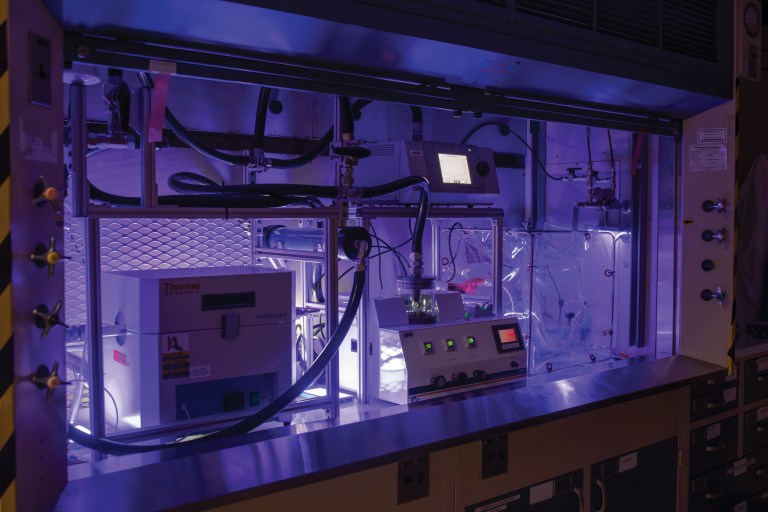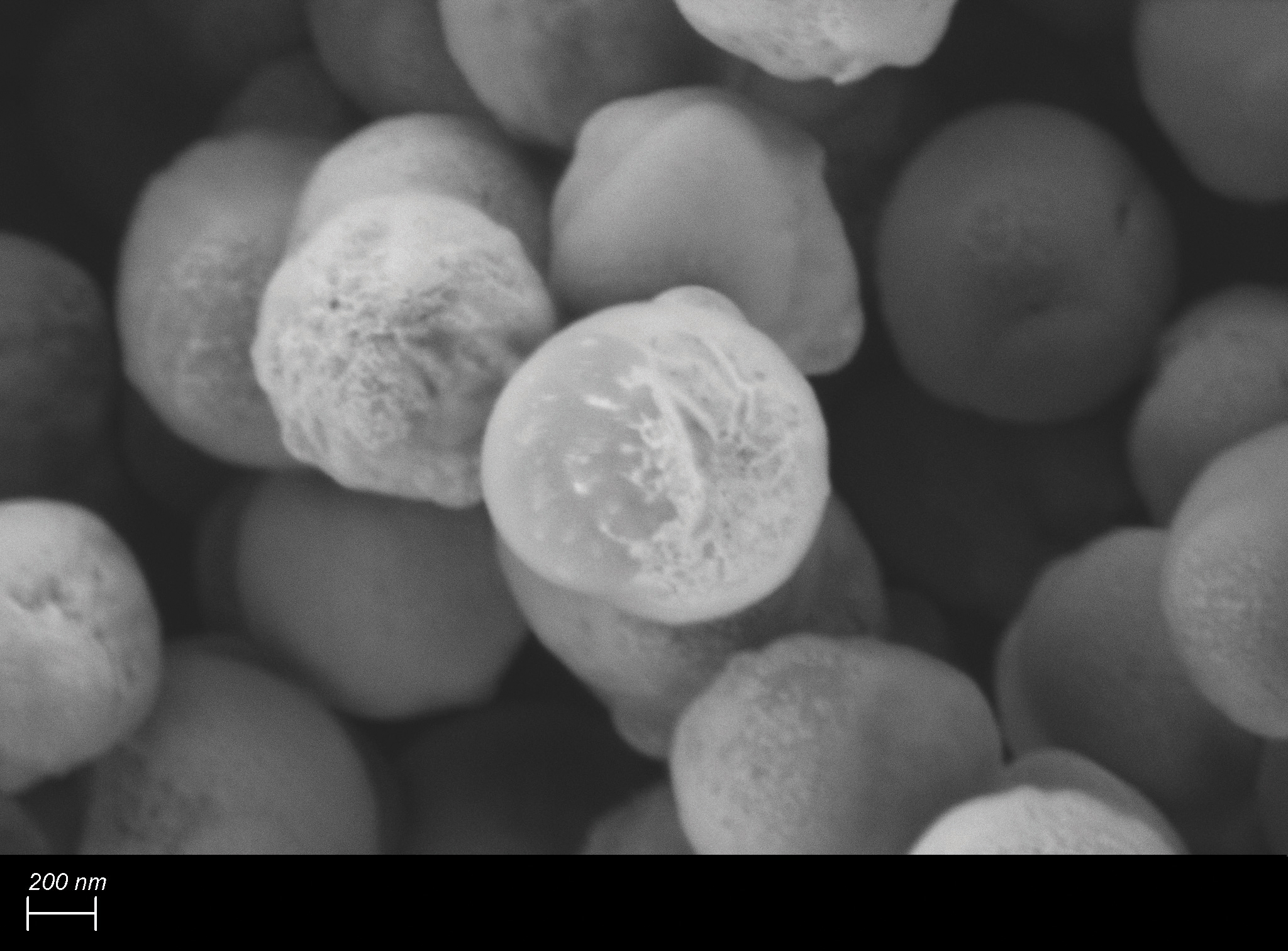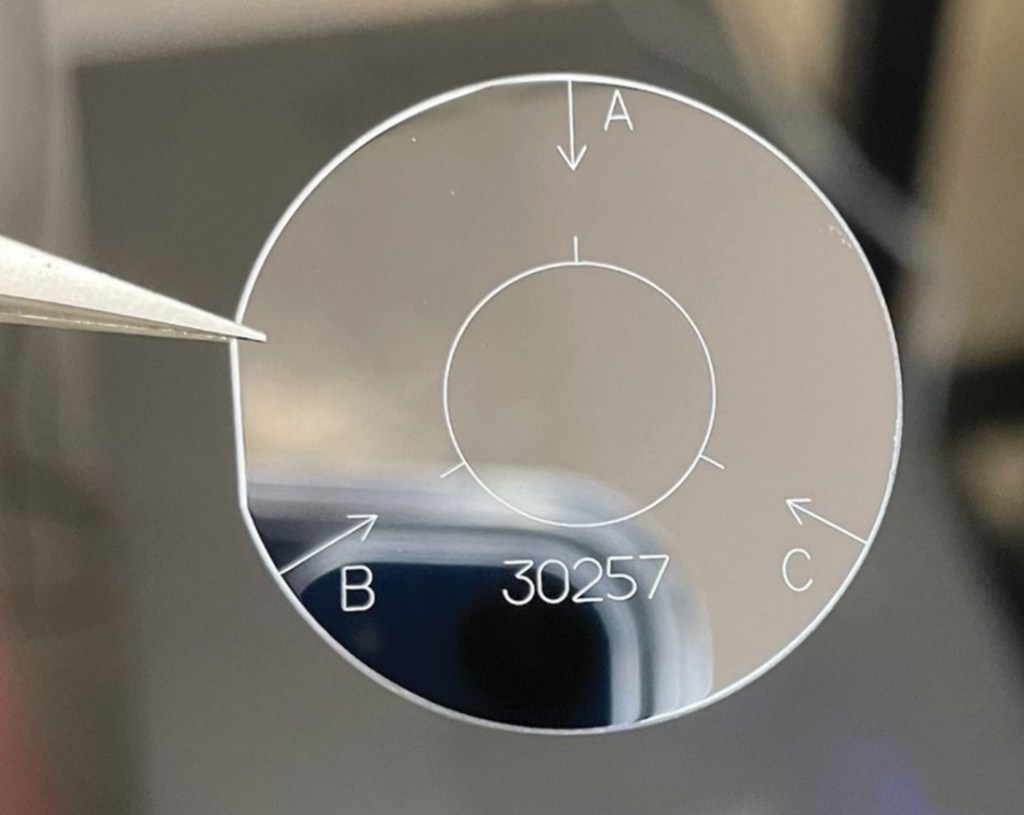“It seemed like a golden opportunity. SRNL is a smaller lab, but we were in a position, based on prior work, competencies and skill sets to do something unique and valuable for the international nuclear safeguards community.” – Matt Wellons

(Illustration: Susanna King, SRNL)
SRNL’s Particle Reference Materials Support Nonproliferation Efforts
Ensuring the safe and effective management of nuclear materials and preventing the spread of nuclear weapons is a matter of national security. The Savannah River National Laboratory is contributing to nuclear nonproliferation by providing high-quality particle reference materials using their THermally Evaporated Spray for Engineered Uniform particulateS (THESEUS) platform.
The prioritization of particle reference materials by the International Atomic Energy Agency (IAEA) Department of Safeguards has enabled the accurate analysis of particles found in environmental samples from nuclear facilities around the world and allows the IAEA to verify compliance with treaty obligations on the peaceful use of nuclear materials and technologies. Particle reference materials are an important tool for laboratories performing particle analysis on environmental samples. They are used for quality assurance, method development, method calibration, and establishing the metrological traceability of measurement results by the IAEA and other US government agencies.
To philosophy enthusiasts the Ship of Theseus thought experiment challenges our perception of an object’s changing substance. SRNL’s THESEUS platform lives up to its name by having most of the platform’s components replaced for each use. This ensures lingering material from previous work doesn’t change the intended properties of the current material.
SRNL’s particle reference materials are micrometer-sized particles of custom elemental and isotopic composition that are uniform in size and homogeneous in isotopic and elemental composition. A particle batch delivered to the IAEA may contain up to 10 billion particles, and they must be compositionally identical with fewer than 1:1000 having unintended compositions.
Particles produced by THESEUS are collected using electrical charges (electrostatic precipitation) on planchets or through gravity-settling onto substrates. The collected particles are characterized using a suite of analytical techniques both at SRNL and Los Alamos National Laboratory. These particle standards were initially developed as part of the Safeguards Technology Development Program (NA-241) in the National Nuclear Security Administration’s Office of International Nuclear Safeguards and were ultimately transferred to support the IAEA’s nonproliferation efforts.

THESUS Instrumentation (Photo: Laura Russo, SRNS)
The Culmination of Years of Work
The SRNL particle reference material program was seeded in 2013 as part of the SRNL Laboratory Directed Research and Development (LDRD) program. At that time SRNL was analyzing the aging dynamics of uranium particles in the environment. As a part of that project, a particle generator system was developed to make uranium particles and the project team also received approval to attempt to create plutonium particles.
“Seeing the particles that originated from those very simple systems at the time was exciting,” said Matt Wellons, SRNL advisory program manager. “The team liked what we saw and thought they would be really good test materials.”
While the team didn’t have a background in nuclear safeguards, they had successfully navigated the engineering and safety approval process to handle and manipulate particularly hazardous radioactive materials. This later helped them communicate to sponsors about their ability to handle enriched uranium and plutonium and perform research and development to generate test materials. A few years later, a second LDRD award helped mature SRNL’s particle generation techniques and ultimately allowed the team to answer a request from NNSA’s Office of Nonproliferation and Arms Control to produce reference particles which led to the conceptualization and development of THESEUS.

Uranium reference particles. (Photo: SRNL Trace Nuclear Measurement Technology)
The THESESUS Process
Once SRNL receives a request to create materials, researchers use a combination of commercially purchased and in-house feedstock materials to generate custom elemental and isotopic feedstock solutions. The liquid feedstock solution is then injected into the THESESUS platform. THESEUS aerosolizes the solution into microscopic droplets that fly through conductive silicone tubing to a drier tube and tube furnace where the aerosolized feedstock droplets are dried and solidified in-flight prior to deposition (either gravimetric or electrostatic) and collection.
“It was very exciting. We leveraged a lot of information from our experience and training in aerosol science to coordinate with the vendors that sell that instrumentation,” said Wellons. “It seemed like a golden opportunity. SRNL is a smaller lab, but we were in a position, based on prior work, competencies and skill sets to do something unique and valuable for the international nuclear safeguards community.”
During the last decade, SRNL has worked with Los Alamos and Pacific Northwest National Laboratories, the National Institute of Standards and Technology and the IAEA, to refine the production and characterization technology to produce particle reference materials. SRNL is one of three labs in the world that are qualified to provide particle reference material production support to the IAEA.
Since the conclusion of both LDRD projects, the SRNL particle program has received continual funding from NA-241, as well as the Department of State through the International Safeguards Project Office, for the provision of reference materials to the IAEA. SRNL continues to provide high-quality, well-characterized, microparticle reference materials to the IAEA and other government agencies.
In 2023, SRNL made history by becoming the first national lab to produce mixed U/Pu microparticle reference materials for the international community – a material unlike any others produced in the last 40 years. This accomplishment is the result of extensive investment, innovation, and advocacy by SRNL, NNSA and their partner institutions.
Historically, the international nuclear safeguards community, under the IAEA, has not had access to microparticle reference materials with certified uranium and plutonium compositions. SRNL’s successful production of these reference materials fills this gap, enhancing microanalytical measurement traceability.
Distributing these materials globally will strengthen the international nuclear safeguards system and support the development of next-generation analytical methods and technologies. The production of reference particle materials highlights SRNL’s advanced production technology of creating precisely controlled and complex microparticles and paves the way for the development of new and unexplored material formulations in the future.

Mixed U/Pu particle planchet. (Photo: SRNL)